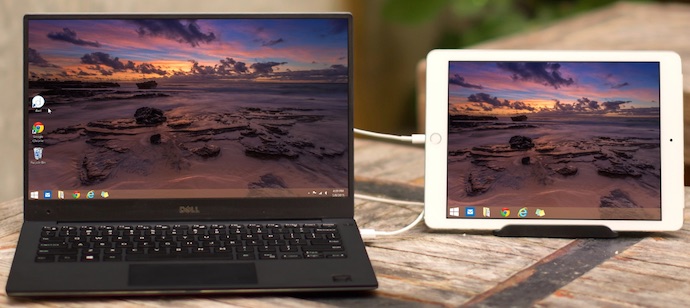
Duet is a popular second screen app for the iPad
Why a Second Screen?
Because science! Actually it’s true, scientific studies have proven that having an additional display makes you more productive. Multiple screen makes today’s multi-tasking world a heck of a lot easier, requiring less mousing and less squinting due to trying to jam all your open apps into a single limited space. You can read the details in my post on the advantages of multiple monitors, but if you’ve used a multiple monitor setup at work or seen one in a store, you already know it’s pretty much a no-brainer that it’s a big improvement. Personally, I like to have my main display devoted to the task at hand—in my case, that’s usually writing—while my second screen displays updating information like my e-mail and Twitter.
Unfortunately, two things can sometimes get in the way of that second display setup: cash and space.
The reality is, manufacturers aren’t giving monitors away for free. Physical desk space can often be at just as high a premium as desktop space on your PC or laptop display, so even if a new monitor is in the budget there may not be the room for it.
Use Your Tablet!
You may not realize it, but you can use your tablet (or even your smartphone) as that elusive second display. Not money needed to buy a new monitor and the space requirements are miniscule. Even better, there are (often) no wires!
All you need is an app for your mobile device (there may be a corresponding app for the PC side of things). Developers have made versions available for pretty much every platform combination—Mac and Windows on the PC side, iOS, Android and Windows on the mobile side. Popular choices include AirDisplay, iDisplay, Splashtop and Duet and most range from around $5 to the $10 range. Just Google your PC and tablet combo to find the apps that support your setup.
Adding an iPad Air 2 as a second display for a MacBook Air for example, results in a second screen with higher resolution than the laptop’s own display. That’s a big win.

Wired or Wireless
I just said that there are often no wires and that’s true. Many of these second screen apps connect to the host PC using Wi-Fi or Bluetooth. However, there is one drawback to going wireless and that’s lag. It’s not really noticeable if you’re using that second to display standalone info, but if you mouse between screens, there can be a slight delay in movement.
That’s why some apps—like Duet—support a wired connection. This eliminates the lag.
Pro Tip: Get a Stand
Using a tablet or iPhone is all about saving money and space, but there’s one expenditure I’d highly recommend and that’s an adjustable stand for the mobile device.
These are quite inexpensive and they can actually save you some desk space by keeping the device vertical. A stand is also much more ergonomic than leaving a tablet flat or propped up against something. And when you aren’t using it to turn your mobile device into a second screen, a stand has additional uses such as positioning your tablet perfectly for watching streaming video or following a recipe in the kitchen.
It’s also worth noting that the hardware requirements on the mobile device side are usually quite modest, so doing duty as a second screen can actually be a very useful second life for an older tablet you have stashed in a drawer.



